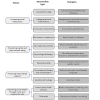Social Prescription Interventions Addressing Social Isolation and Loneliness in Older Adults: Meta-Review Integrating On-the-Ground Resources
- PMID: 37195738
- PMCID: PMC10233446
- DOI: 10.2196/40213
Social Prescription Interventions Addressing Social Isolation and Loneliness in Older Adults: Meta-Review Integrating On-the-Ground Resources
Abstract
Background: Social prescription programs represent a viable solution to linking primary care patients to nonmedical community resources for improving patient well-being. However, their success depends on the integration of patient needs with local resources. This integration could be accelerated by digital tools that use expressive ontology to organize knowledge resources, thus enabling the seamless navigation of diverse community interventions and services tailored to the needs of individual users. This infrastructure bears particular relevance for older adults, who experience a range of social needs that impact their health, including social isolation and loneliness. An essential first step in enabling knowledge mobilization and the successful implementation of social prescription initiatives to meet the social needs of older adults is to incorporate the evidence-based academic literature on what works, with on-the-ground solutions in the community.
Objective: This study aims to integrate scientific evidence with on-the-ground knowledge to build a comprehensive list of intervention terms and keywords related to reducing social isolation and loneliness in older adults.
Methods: A meta-review was conducted using a search strategy combining terms related to older adult population, social isolation and loneliness, and study types relevant to reviews using 5 databases. Review extraction included intervention characteristics, outcomes (social [eg, loneliness, social isolation, and social support] or mental health [eg, psychological well-being, depression, and anxiety]), and effectiveness (reported as consistent, mixed, or not supported). Terms related to identified intervention types were extracted from the reviewed literature as well as descriptions of corresponding community services in Montréal, Canada, available from web-based regional, municipal, and community data sources.
Results: The meta-review identified 11 intervention types addressing social isolation and loneliness in older adults by either increasing social interactions, providing instrumental support, promoting mental and physical well-being, or providing home and community care. Group-based social activities, support groups with educational elements, recreational activities, and training or use of information and communication technologies were the most effective in improving outcomes. Examples of most intervention types were found in community data sources. Terms derived from the literature that were the most commonly congruent with those describing existing community services were related to telehealth, recreational activities, and psychological therapy. However, several discrepancies were observed between review-based terms and those addressing the available services.
Conclusions: A range of interventions found to be effective at addressing social isolation and loneliness or their impact on mental health were identified from the literature, and many of these interventions were represented in services available to older residents in Montréal, Canada. However, different terms were occasionally used to describe or categorize similar services across data sources. Establishing an efficient means of identifying and structuring such sources is important to facilitate referrals and help-seeking behaviors of older adults and for strategic planning of resources.
Keywords: database management; intervention; knowledge mobilization; loneliness; older adults; ontology; social isolation; social prescription.
©Catherine Paquet, Jocelyne Whitehead, Rishabh Shah, Alayne Mary Adams, Damion Dooley, R Nathan Spreng, Anna-Liisa Aunio, Laurette Dubé. Originally published in the Journal of Medical Internet Research (https://www.jmir.org), 17.05.2023.
Conflict of interest statement
Conflicts of Interest: None declared.
Figures




References
-
- DeVoe J, Bazemore AW, Cottrell EK, Likumahuwa-Ackman S, Grandmont J, Spach N, Gold R. Perspectives in primary care: a conceptual framework and path for integrating social determinants of health into primary care practice. Ann Fam Med. 2016 Mar;14(2):104–8. doi: 10.1370/afm.1903. http://www.annfammed.org/cgi/pmidlookup?view=long&pmid=26951584 14/2/104 - DOI - PMC - PubMed
-
- Pilkington K, Loef M, Polley M. Searching for real-world effectiveness of health care innovations: scoping study of social prescribing for diabetes. J Med Internet Res. 2017 Mar 02;19(2):e20. doi: 10.2196/jmir.6431. https://www.jmir.org/2017/2/e20/ v19i2e20 - DOI - PMC - PubMed
-
- Polley M, Pilkington K. A review of the evidence assessing impact of social prescribing on healthcare demand and cost implications. University of Westminster. 2017. [2022-02-21]. https://westminsterresearch.westminster.ac.uk/item/q1455/a-review-of-the... .
-
- Nowak DA, Mulligan K. Social prescribing: a call to action. Can Fam Physician. 2021 Mar 19;67(2):88–91. doi: 10.46747/cfp.670288. http://www.cfp.ca/cgi/pmidlookup?view=long&pmid=33608356 67/2/88 - DOI - PMC - PubMed
-
- Andermann A, CLEAR Collaboration Taking action on the social determinants of health in clinical practice: a framework for health professionals. CMAJ. 2016 Dec 06;188(17-18):E474–83. doi: 10.1503/cmaj.160177. http://www.cmaj.ca/cgi/pmidlookup?view=long&pmid=27503870 cmaj.160177 - DOI - PMC - PubMed
Publication types
MeSH terms
Grants and funding
LinkOut - more resources
Full Text Sources

